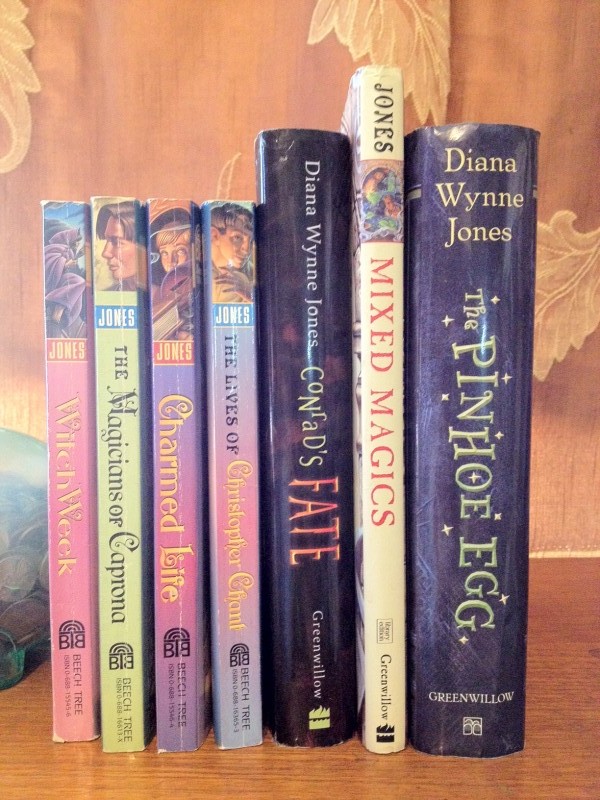Today is August 16th, what would have been Diana Wynne Jones’s 78th birthday. She passed away in the spring of last year, and while the entire world was not sad, the parts of it that knew her were very sad indeed.
I discovered Jones thanks to my mother, and much of the landscape of my adolescent imagination was influenced by her work. I taught myself to read by struggling through Hexwood, and when I began writing down my stories, I turned to her for guidance. More than any other author that has ever lived, she is the one I look to for inspiration, for encouragement, and for entertainment.
In other words, she is my favorite writer, and on the occasion of her birthday I’d like to take a moment to talk about a particular series she wrote, in the hopes that it may entice others to begin reading her. And so, I am very pleased to present:
Goldeen Ogawa’s Unofficial Guide to Reading Chrestomanci

The Chrestomanci Books by Diana Wynne Jones are possibly the finest collection of children’s fantasy stories ever written. I do not mean to say they are for children (though they are that), because the stories are complex and nuanced enough that they will be interesting to any adult who can swallow their grown-up pride long enough to read the first page or two (after that they will be hooked). No, I mean they are children’s fantasy because the heroes are all children; the stories are about children and the issues children have. I think they are good books for kids and adults: good for kids because they are about kids, and good for adults… because they are about kids. (Adults, having once been kids, seem to forget what it was like. These books will remind them.)
There is a lot of magic in these books. More magic than Harry Potter, more than The Chronicles of Narnia, and though I don’t mean to compare the Chrestomanci books directly to these two classics, if you were to measure a story based on how much magic was in it, the Chrestomanci books would win by several orders of magnitude.
So: children’s fantasy (the best kind of fantasy there is, in my opinion). Brilliant, perceptive writing, with the kind of sympathies children will appreciate. The entire series is available as eBooks on Amazon, and paperback copies are fairly easy to find. Excellent.
The problem a lot of people have is figuring out where to start. Because, like the Narnia books, the Chrestomanci books were written out of order. Furthermore, they are all stand-alone stories, so it really shouldn’t matter what order you read them in, just so long as you read them all. Finally, to really get the whole picture, you need to read not only the six novels, but the collection of short stories set in the same world(s). Again, it does not matter which order you read these in, just so long as you read them all.
But where to start?
What follows is a rundown of the different orders in which one my enjoy these books, concluding with the one I would recommend. I hope they are useful.
1: Chronological Order
Popular opinion has it that these stories should be read in the order in which they happen. This is usually a safe bet when it comes to most series, but the Chrestomanci books present a challenge in that it is debatable where some of the books go. As near as I can make out the chronological order is:
1: The Lives of Christopher Chant (novel)
2: Conrad’s Fate (novel)
3: Charmed Life (novel)
4: Warlock at the Wheel (short story)
The Sage of Theare (short story)
The Magicians of Caprona (novel)
7: Stealer of Souls (short story)
8: Carol Oneir’s Hundredth Dream (short story)
9: Witch Week (novel)
10: The Pinhoe Egg (novel)
Immediately we begin to run into difficulties. As you can see I have three stories listed fourth: this is because I simply have no way of figuring out which came first, though it is a safe bet they all happen after the events of Charmed Life and before the events of Stealer of Souls. Moreover, Witch Week happens some time after Charmed Life, but that is all I can tell for sure.
2: Publication Order
If one wants to avoid ambiguity, one can always do what I do when reading The Chronicles of Narina: that is, read them in the order they were written. Using this method the books fall into the following order:
1977: Charmed Life
1980: The Magicians of Caprona
1982: Witch Week
1982: The Sage of Theare
1984: Warlock at the Wheel
1986: Carol Oneir’s Hundredth Dream
1988: The Lives of Christopher Chant
2000: Stealer of Souls
2005: Conrad’s Fate
2006: The Pinhoe Egg
I’m not a fan of this order because I feel it will give the reader a somewhat jumbled experience, as the events of Magicians of Caprona, Stealer of Souls and Carol Oneir’s Hundredth Dream run from one to the other respectively. Not so as you have to read them all at once, but it’s best if they’re read in that order.
It must also be remembered that the four short stories have been handily collected in the book Mixed Magics, so they may be taken all together.
3: My Recommended Order
However there is another way of ordering them: if you look at the dates you’ll see there is a rather large gap between The Lives of Christopher Chant and Stealer of Souls, and there is a similar gap in the style of the writing. All the books are good, but I find the later ones to be, on the whole, more cheerful and optimistic. So if you were to ask me to read the books to you, this is the order in which I would read them:
1: Witch Week (novel, 1982)
Why? Witch Week was the first Chrestomanci novel I read, so perhaps I am biased. But on closer inspection I think it really is the best introduction to the series, and to the character of the Chrestomanci. The entire story is set up, it seems, to explain how the Chrestomanci and the Related Worlds work. For this reason alone, I would read it first.
2: The Magicians of Caprona (novel, 1980)
Why? It’s fun. It’s silly. It’s set in an alternate Italy! And it has slightly more Chrestomanci in it than Witch Week. It is also one of the few books in the series that does not involve world-hopping, which makes it a nice contrast to what comes next.
3: Charmed Life (novel, 1977)
Why? The reason I don’t like reading Charmed Life first is because I don’t think it’s a very good introduction to the series. There are a lot of distasteful characters in it, and Chrestomanci himself is shown in a rather poor light. You have to have faith in the world and the writer, which, after reading Witch Week and Magicians of Caprona, you should have. Needless to say, it pays off loads in the end, but first you have to get there.
4: The Lives of Christopher Chant (novel, 1988)
Why? Now that we’ve heard a few stories about the current Chrestomanci, it is a good time to go back and read about how he got that way. Christopher Chant is a lot more fun if you’ve already read Charmed Life, even though chronologically it takes place over twenty years earlier.
5: Conrad’s Fate (novel, 2005)
Why? Conrad’s Fate is another pre-Cat story, taking place only a few years after the events in Christopher Chant, and makes a natural continuation of that story.
6: Mixed Magics: Four Tales of Chrestomanci (short story collection, 1982-2000)
Why? The stories here span over twenty years of writing, and you can really see the difference in Jones’s style. While I don’t much care for Warlock at the Wheel, and I find Sage of Theare to be a little disconcerting, Stealer of Souls and especially Carol Oneir’s Hundredth Dream are fantastic, and they set things up nicely for the final book.
7: The Pinhoe Egg (novel, 2006)
Why? This is the last book. The one thing all these lists have in common is this: read The Pinhoe Egg last. It’s not an ending, per se, but it’s sort of the biggest story, drawing in characters from almost all the previous stories—not so’s you need to have read the earlier books, but having done so will greatly enhance the experience of this one. Finally, I think The Pinhoe Egg is probably the best of the whole lot. And considering how spectacular these books are, that’s saying something.
One could also argue that it takes place during the summer before the events of Witch Week, which gives one an excuse to go back and start reading the whole series all over again. Which is the way I like to end things: with new beginnings.
Goldeen Ogawa was born on August 15th, just one day shy of Jones’s birthday. She is not sure whether she is happy to be born so close, or disappointed that she missed it. You can email her at goldeenogawa@gmail.com or peck at her on Twitter @GrimbyTweets.
Diana Wynne Jones wrote dozens of books, all of them good, most of them fantastic. Her other works include Howl’s Moving Castle, Dark Lord of Derkholm, The Homeward Bounders, The Merlin Conspiracy, and Goldeen’s favorite book of all time: Hexwood. Her official fan site can be found here.



























